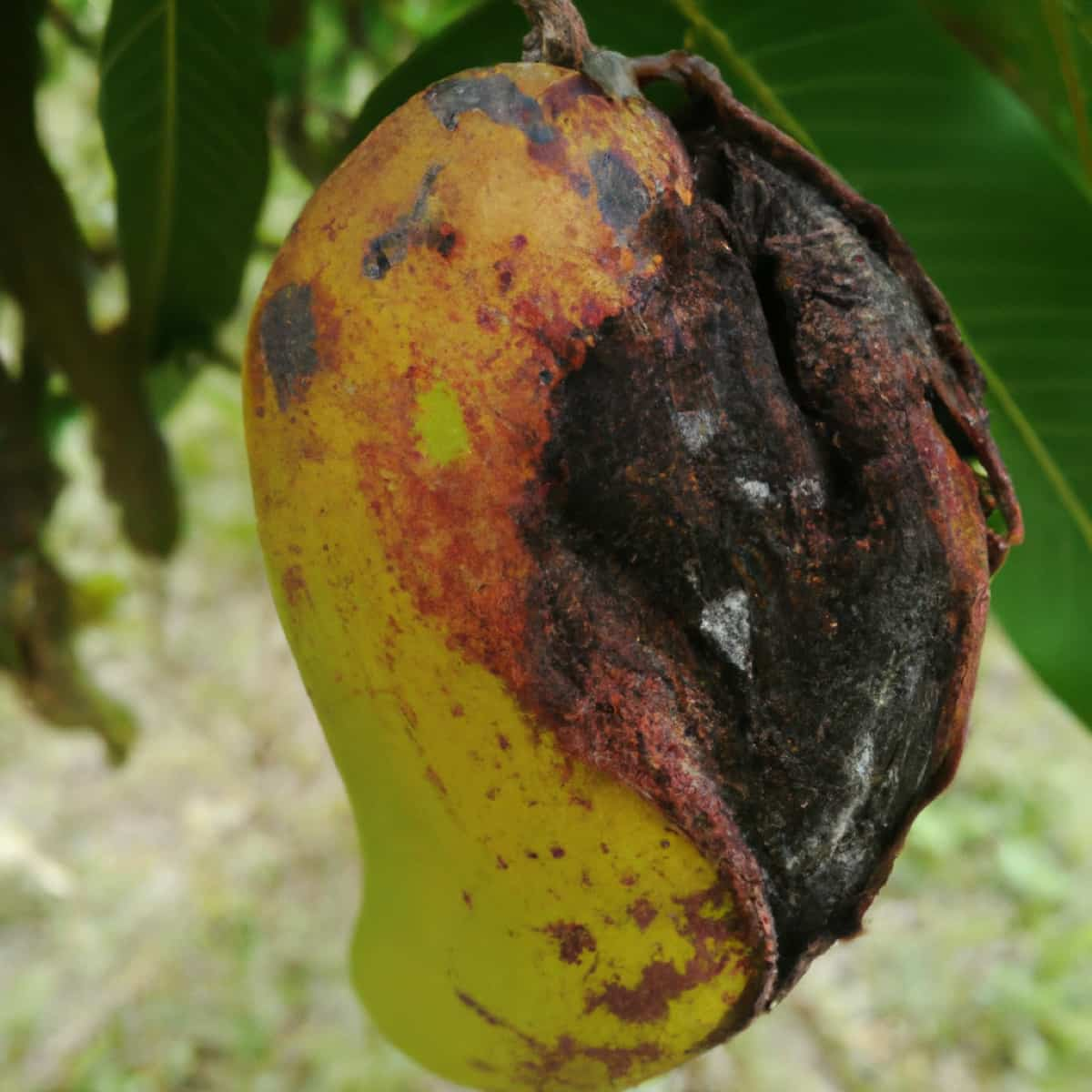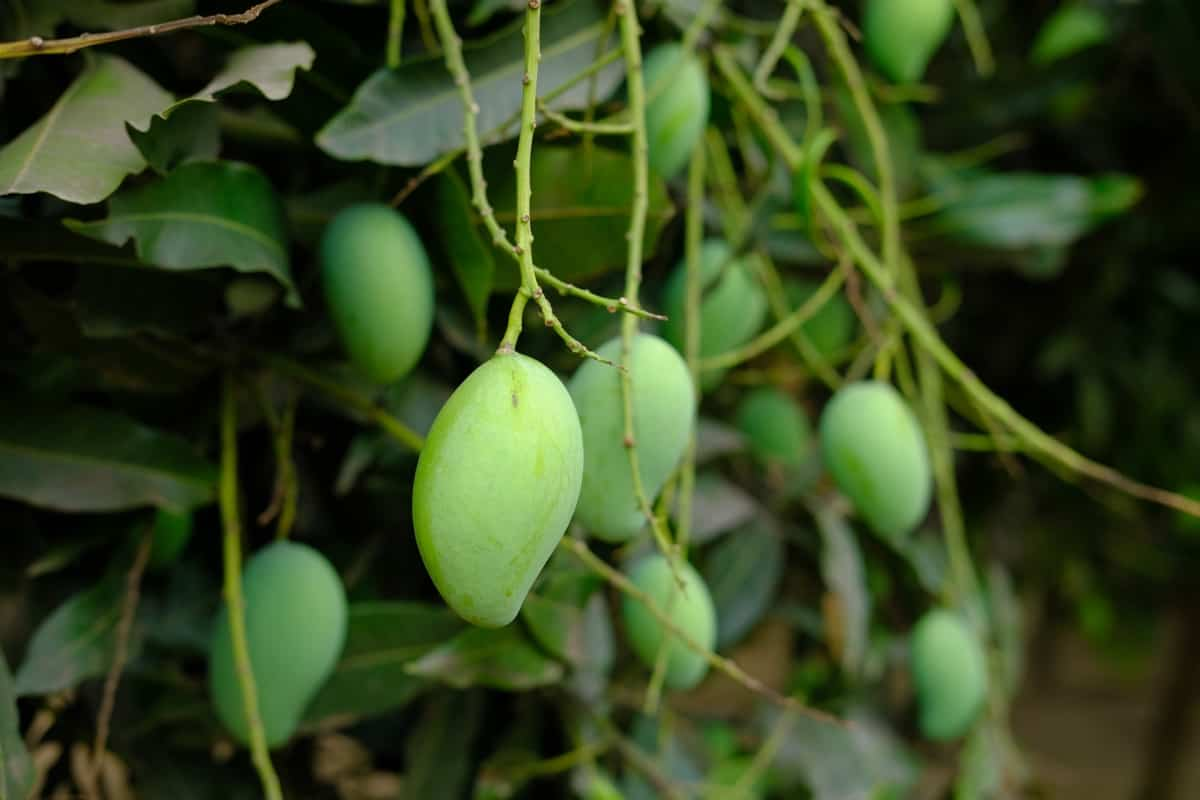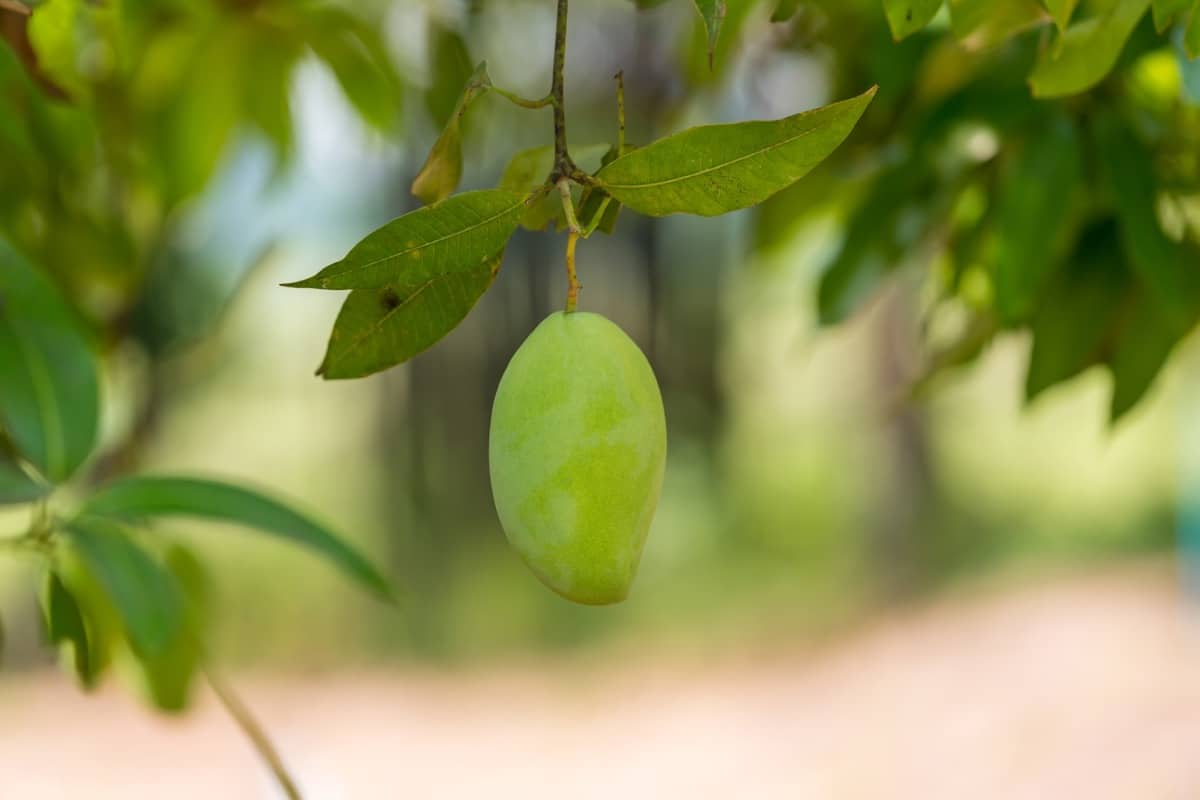The Mango Stem End Rot Disease is a destructive fungal disease caused by the fungus Diplodia natalensis, also known as Diplodia tip blight. It is believed to have originated in South Africa. It affects the stem end of the mango fruit, causing rot and decay. The fungus attacks the mango fruits and causes the fruit’s stem end to rot and eventually fall off. The fungus produces spores that can survive up to 3 months in a dry environment.

Infected fruits are more susceptible to other diseases, such as anthracnose and scab. Good agricultural practices such as proper irrigation, adequate nutrient supply, and crop rotation can also help reduce disease incidence. To effectively manage this disease, it is important to understand its disease cycle, the mode of disease spread, and the best methods for controlling it. This article will provide an overview and discussion of the Mango Stem End Rot Disease in Mango crops, including its symptoms, identification techniques, and control.
Mango Stem End Rot Disease Management
The Causal Organism of Mango Stem End Rot Disease
- Diplodia natalensis is an obligate parasite that belongs to the Family Botryosphaeriaceae of Order Botryosphaeriales of the Phylum Ascomycota.
- The fungus produces fruiting bodies that are brown to black, pear-shaped, ostiolate, and globose. There are two types of conidia produced in the pycnidium. One is single-celled, thin-walled, and transparent. The other is two-celled, thick-walled, and with six longitudinal stripes.
- These pycnidia contain spores spread by wind and rain, allowing the fungus to infect new plants.
The Disease Cycle of Mango Stem End Rot Disease
The disease cycle of the Mango Stem End Rot Disease, Diplodia natalensis, in Mango Crops begins with the initial infection of the tree, which usually occurs during the flowering stage when wind-blown spores spread the fungus. These spores land on the mango tree’s flowers, fruits, and stems, where they germinate and form mycelium, a mass of branching fungal filaments.
The fungus’s mycelium then penetrates the mango fruits’ surface, forming fruiting bodies which produce secondary spores. These secondary spores are released into the air and can spread to other mango trees, infecting them with the disease. Once the disease has infected a mango tree, the fungus will cause rot at the fruit’s stem end. This rot is usually characterized by soft, brown, and watery spots, which can eventually spread to the entire fruit, causing it to develop a characteristic “dark spot.”
The fungus can also colonize the wood and bark of the tree, causing cankers, which can eventually girdle the trunk and branches, leading to dieback. The fungus can thrive in the humid and warm environment of the mango tree and can remain active for many years, even without new infections.
Occurrence of Mango Stem End Rot Disease in Mango Crop
- Location of Mango Stem End Rot disease: This disease occurs in mango crops in India, Bangladesh, Sri Lanka, Thailand, the United States, Mexico, Brazil, and Australia.
- Host range: The most common crops affected by Mango Stem End Rot Disease are mango, papaya, guava, banana, citrus, and avocado.
Favorable Conditions for Mango Stem End Rot Disease Spread in the Field
- Warm and humid environmental conditions favor the disease. A high temperature above 27°C and high relative humidity above 80% is ideal for the rapid growth and spread of the fungus.
- The disease is also favored by high rainfall and flooding, which can increase the spread of the spores.
- Frequent pruning and harvesting of mango trees, which creates wounds in the trees and provides an entry point for the spores of the fungus. And pruning increases the deadwood in the canopy, which can act as a reservoir for the fungus.
- The presence of insects, such as fruit flies, can act as disease vectors. These insects feed on the sap of the mango trees and can spread the spores.
- Poor agricultural practices, such as excessive use of nitrogen-rich fertilizers, can encourage the growth of the fungus. The fungus can also spread through contaminated pruning tools, infected fruit, irrigation water, and wind-borne spores.
In case you missed it: Mango Powdery Mildew Disease Management: Symptoms, Treatment, Chemical, Biological, Natural, and Organic Control

Damage Symptoms of Mango Stem End Rot Disease
- This disease is characterized by stem and twig dieback, fruit rot, and reduced yield. The affected parts of the tree are typically covered in dark, sooty-looking spores.
- On fruit, the disease causes the fruit pulp to become soft, discoloration, premature fruit fall, rotting of the stem end of the fruit, and a soft rot that is brown and emits a foul and musty odor.
- The disease causes stem cankers, dieback, and wilting on twigs and branches.
- Presence of dark spots at the fruit’s stem end and a soft, brown rot that develops over time.
- Once the fungus enters the plant, it colonizes the vascular bundles resulting in girdling.
- The stem cankers that form are usually dark brown to black and may be surrounded by a yellow halo. These cankers often cause the stem to break or crack, leading to premature fruit drop.
Percentage of Yield Loss Due to Mango Stem End Rot Disease in Mango Crop
- The disease can cause 10-80% yield losses in the United States. In Mexico, yield losses are between 15-20%. In India, the yield losses are between 10-50%. In Bangladesh, it is 10-20%. In China, a 5-20% yield loss is seen. In Thailand, it is between 10-30%.
- In Africa, yield losses are between 10-50%. In the Philippines, it is 5-15%. In Brazil, it is 10-25%. The Economic Threshold Level is determined at 5-10% of the fruits with symptoms.
Cultural Control Measures of Mango Stem End Rot Disease
- Prune the trees regularly to remove infected branches and allow air and light to reach the lower branches. This will reduce the chance of the fungus spreading.
- Perform weeding regularly because they can act as hosts for the fungus and can spread it to other mango trees.
- Practicing mulching in the orchards helps to keep the soil moist and reduce the chances of the fungus spreading.
- Good sanitation practices should be followed in the orchard, the debris should be removed, and tools should be disinfected between uses.
- Perform Roguing out operations, remove and destroy the diseased plants.
Biological Control Measures of Mango Stem End Rot Disease
- Predatory mites, such as Neoseiulus californicus and Amphitetranychus hookeri, feed on the fungal spores of Diplodia natalensis and help to reduce the number of spores in the environment.
- Trichoderma spp. are beneficial fungi that produce enzymes that can inhibit the growth of the pathogen.
- The fungus, Beauveria bassiana parasitizes the pathogen causing it to stop producing spores and reducing the amount of disease in the environment.
- Beneficial bacteria, such as Pseudomonas fluorescens, produce compounds that can inhibit the growth of the pathogen.
Chemical Control Measures of Mango Stem End Rot Disease
- Spray the fungicides Carbendazim, Mancozeb, Chlorothalonil, Copper Oxychloride, and Thiophanate Methyl every two weeks in the rainy season to control stem end rot disease in mango.
- Insecticides – Spray Imidacloprid and Cryomazine to kill the scale insects in mango crops to prevent them from transmitting the disease to other plants.
- Foliar sprays – These sprays wash away the spores, preventing them from spreading to other plants. Common foliar sprays include potassium bicarbonate, wettable sulfur, and lime sulfur.
Organic Control Measures of Mango Stem End Rot Disease
- Neem oil, Garlic oil, and other natural fungicides such as copper sulfate, potassium bicarbonate, and sulfur are the most used natural fungicides to control mango stem-end rot disease.
- Collect the affected plant parts from the orchard and bury them in a pit at one corner of the field to control the disease spread.
Preventive Measures for Control of Mango Stem End Rot Disease
- Monitor the soil moisture level and avoid over-watering the mango trees. Maintain the soil moisture level in the 55-65% range to prevent the disease.
- Regularly monitoring fields for signs of disease, such as wilting leaves, rot spots, and cankers, will help to catch and manage it early before it spreads.
- Planting mango varieties that are resistant to the fungus can reduce the spread and severity of the disease.
- Planting other crops in the same field for a year or two can help to reduce the spread of the disease.
- Avoid overcrowding by practicing proper crop spacing in the orchards and avoiding contact between infected and healthy plants.
In case you missed it: Mango Anthracnose Disease Management: Symptoms, Treatment, Chemical, Biological, Natural, and Organic Control

Conclusion
The mango stem-end rot disease is a serious crop issue worldwide, causing significant crop loss and economic damage. Adopting integrated disease management practices such as crop rotation, sanitation measures, and fungicide treatments can help minimize the effects of this disease and reduce losses in mango production.
- Beneficial Insects in Pest Management
- Natural Solutions for Pest Control in Flower Gardens
- Types of Fungicides Used in Agriculture
- Common Issues in the Fruit Development Stage of Pomegranate Farming
- Fruit Development Issues in Papaya: Easy Solutions and Treatment
- Soil-Borne Diseases and How to Protect Your Plants
- Practices to Prevent Disease Spread in the Garden
- From Wilted to Thriving: How to Treat Root Rot Naturally in Houseplants
- Natural Remedies to Cure Brown Spots on Fig Tree Leaves